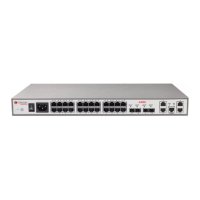A10E/A28E/A28F Configuration Guide
The A10E/A28E supports the following two ARP address mapping entry dynamic learning
modes:
Learn-all: in this mode, the A10E/A28E learns both ARP request packets and response
packets. When device A sends its ARP request, it writes mapping between its IP address
and physical address in ARP request packets. When device B receives ARP request
packets from device A, it learns the mapping in its address table. In this way, device B
will no longer send ARP request when sending packets to device A.
Learn-reply-only mode: in this mode, the A10E/A28E learns ARP response packets only.
For ARP request packets from other devices, it responds with ARP response packets only
rather than learning ARP address mapping entry. In this way, network load is heavier but
some network attacks based on ARP request packets can be prevented.
3.1.2 Preparing for configurations
Scenario
The mapping relation of IP address and MAC address is stored in ARP address mapping table.
Generally, ARP address mapping table is dynamic maintained by the A10E/A28E. The
A10E/A28E searches the mapping relation between IP address and MAC address
automatically according to ARP protocol. Users just need to configure the A10E/A28E
manually for preventing ARP dynamic learning from cheating and adding static ARP address
mapping table entry.
Prerequisite
N/A
3.1.3 Default configurations of ARP
The default configuration of ARP is as below.
Dynamic ARP entry learning mode
3.1.4 Configuring static ARP table entries
The IP address in static ARP table entry must belong to the IP network segment of
switch Layer 3 interface.
The static ARP table entry needs to be added and deleted manually.
Configure static ARP table entries for the A10E/A28E as below.
Enter global configuration mode.

